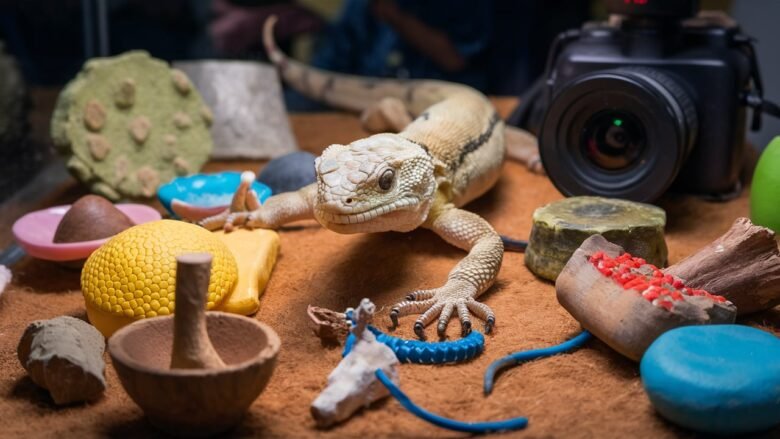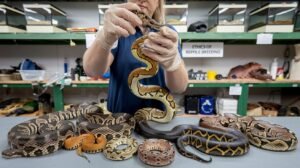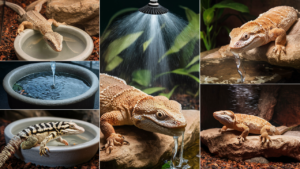Reptile sensory enrichment is crucial for the well-being of reptiles, stimulating their senses and enhancing their cognitive functions. This article delves into effective strategies and sensory toys that can significantly uplift reptile habitats, ultimately improving their overall perception and quality of life.
Understanding Reptile Sensory Systems
Understanding Reptile Sensory Systems: Reptiles utilize specialized sensory systems that differ significantly from mammals. Their vision often includes ultraviolet sensitivity, enhancing their environmental awareness. Smell is paramount, using Jacobson’s organ for chemoreception, which aids in locating food and mates. Touch, although underappreciated, is vital for navigating diverse terrains. These sensory modalities contribute to unique behavioral patterns, guiding interaction with their habitats. By recognizing these differences, enrichment strategies can be tailored, ensuring that reptile toys and environments resonate with their distinct perceptual experiences.
The Importance of Sensory Enrichment: Sensory enrichment is essential for reptile well-being, promoting psychological stability and physical health. Enhanced perceptual experiences lead to decreased stress levels and improved mental health. Activities that engage their senses, such as hiding food in substrates or introducing varied textures, stimulate natural behaviors. Incorporating visual stimuli, like colorful objects, and olfactory cues, like scented plants, reinforces exploratory instincts. By prioritizing sensory enrichment, caregivers can effectively mimic natural habitats, fostering happier, more engaged reptiles.
The Importance of Sensory Enrichment
Sensory enrichment is vital for reptiles, promoting their well-being by reducing stress and encouraging natural behaviors. Engaging activities stimulate mental faculties and improve overall health.
Psychological benefits include reduced anxiety and improved mental health, allowing reptiles to exhibit more natural behaviors while foraging, exploring, or basking, leading to enriched lives.
Activities such as scent trails, varied textures, and interactive feeding can stimulate their senses, enhancing perceptual experiences. These activities foster curiosity and provide mental challenges, making their environments more dynamic.
For instance, utilizing hiding spots filled with different substrates can encourage tactile exploration. This sensory engagement mimics their natural habitats, elevating their quality of life.
Incorporating items with novel scents can captivate their sense of smell, providing cognitive stimulation and making their surroundings more intriguing. Exploring new smells can alleviate boredom, ultimately leading to a healthier, more active reptile.
Simple activities, such as rotating decor or introducing obstacles, can also facilitate mental stimulation. This can invoke innate behaviors such as climbing, hiding, and digging, furthering physical health and mental engagement.
Overall, sensory enrichment is a crucial component in reptile care, leading to enhanced perception, better mood regulation, and exhibition of natural instincts. When implemented thoughtfully, it can significantly transform captive reptiles’ lives.
Innovative Sensory Toys for Reptiles
Incorporating innovative sensory toys elevates reptile care, providing visual stimulation through colorful decors, auditory engagement with natural sounds, and tactile experiences from various textures.
**Visual toys**, like bright, movable decor, attract species with keen sight, encouraging exploration, while **auditory toys**, utilizing sound-producing elements, stimulate curiosity in reptiles sensitive to noise.
**Tactile toys**, featuring diverse surfaces, promote physical interaction, essential for mimicking natural behaviors. Choosing suitable toys requires understanding species-specific preferences and safety of materials to prevent ingestion or injury.
Prioritizing non-toxic, durable materials will ensure safety, while observing individual responses helps identify favorites. Always consider space limitations and the unique needs of each reptile to optimize sensory experiences effectively.
Implementing Sensory Enrichment in Reptile Care
Implementing sensory enrichment in reptiles requires careful planning and observation. Introduce new elements gradually, allowing the reptile to explore without stress. Use scent trails or varied textures to spark curiosity, observing reactions to tailor future enhancements.
Set up a schedule for rotating toys and habitat changes to challenge the reptile continuously. Monitor their engagement with each new addition, making adjustments based on their preferences and behaviors for optimal interaction.
Successful case studies, such as enhancing iguana habitats with climbing structures and aromatic plants, illustrate the significant impact of sensory enrichment. Implementing these changes resulted in increased activity and exploration, enriching their overall quality of life.
Conclusions
Incorporating sensory enrichment into reptile care is not merely beneficial; it is essential for their well-being. Through understanding their sensory systems and providing stimulating toys and environments, we can foster healthier, happier reptiles. Embrace enrichment as a vital aspect of responsible reptile ownership.



